Abstract
Due to the diverse types of sedimentary source supply systems, the research on the distribution patterns of fine-grained sedimentary rocks in rifted lake basins is relatively underdeveloped. The authors of this article selected the lower third member of the Shahejie Formation () in Zhanhua Sag as a research object. Using rock core, thin section, and other data, we analyzed rock types and genesis mechanisms, identified the spatiotemporal distribution patterns of facies within the sag, and established a fine-grained depositional model for the rifted lake basin. Five lithofacies were identified, revealing the differential distribution patterns of fine-grained sedimentary rocks in the region. The northern steep slope zone and the deep depression zone are characterized by the deposition of gravity flow-formed terrestrial layered-pebbly mudstone and gravity flow-formed mixed-source pebbly mudstone, respectively. In the central lake basin zone, mixed-source laminated mudstone with vertical rhythmic interlayers has developed. In the southern gentle slope zone, biologically cemented endogenic irregularly bedded algal limestone and chemically precipitated endogenic laminated limestone have developed. The characteristics of strong northern and weak southern terrestrial inputs in the study area control the differential distribution of lithofacies, and based on this, a fine-grained rock depositional model for the rifted lake basin was established.
1. Introduction
Fine-grained sedimentary rocks are sedimentary rocks mainly composed of particles with a diameter smaller than 62.5 μm. The types of oil and gas contained within them are shale oil and gas [1,2,3]. In recent years, with the increase in shale oil and gas exploration, fine-grained sedimentary rocks have been receiving increasing attention, with the rifted lake basins widely present in the central and eastern parts of China being key targets for shale oil exploration [4,5,6,7]. For example, in the Zhanhua Sag of the Bohai Bay Basin, more than ten core wells have been tested and exploited to obtain industrial oil flow. The peak oil and gas equivalents of five horizontal wells all exceeded 100 m3/d, confirming the enormous exploration and development potential of Paleogene shale oil in the Zhanhua Sag [8]. However, the diverse types of source supply systems in rifted lake basins lead to a complex sedimentary process of fine-grained deposition at different locations. This results in an unclear understanding of the differential distribution patterns of fine-grained sedimentary rocks, thereby constraining shale oil exploration.
Jing Wu et al. [9] researched fine-grained sedimentary rocks in rifted lake basins using the example of the upper submember of Member 4 of the Shahejie Formation in the Dongying Sag. They established a depositional model for the entire basin controlled by the carbonate compensation depth (CCD) by interpreting the relationship between water depth and carbonate. Huimin Liu et al. [10] studied the upper submember of Member 4 of the Shahejie Formation in the Dongying Sag. Based on the sedimentary differentiation principle of terrigenous material input, they established a circumferential distribution pattern for the mud shale in rifted lake basins. Deshun Zhu [11] studied the sedimentary laws of the Zhanhua Sag. Based on the sources of materials, three types of sedimentary facies and six surfaces of deep lakes were roughly classified. The above research offers a better understanding of the material sources and sedimentary patterns of the Dongying Sag within Jiyang Depression. Scholars have gained a deep understanding of the sources and sedimentary patterns within the Dongying Sag in the Bohai Bay Basin. However, research on the Zhanhua Sag has been predominantly confined to the description of fine-grained sedimentary rock deposition characteristics in the deep lake area, lacking a comprehensive study on the lithofacies characteristics and distribution patterns of fine-grained sedimentary rocks throughout the entire depression.
Therefore, we focused on the fine-grained sedimentary rocks of the lower third member of the Shahejie Formation (hereinafter referred to as ) in the Zhanhua Sag and utilized data such as core samples, thin sections, and well-logging and X-ray diffraction information to analyze rock types and genesis mechanisms. Based on this analysis, the spatiotemporal distribution patterns across the entire depression were determined, ultimately establishing a fine-grained rock depositional model for the rifted lake basin. This research is crucial for understanding the formation mechanisms of reservoir heterogeneity in fine-grained sedimentary rocks in the Zhanhua Sag and can provide theoretical support for the exploration and development of shale oil and gas in rifted lake basin settings.
2. Geological Setting
The Bohai Bay Basin is located in eastern China and is a Mesozoic–Cenozoic basin that developed on the foundation of the Sino-Korean craton after the Indosinian and Yanshanian movements. It covers an area of approximately 1.5 × 105 km2. Controlled by the Cenozoic Himalayan movement, the basin began to undergo rifting in the early Eocene and entered the post-rifting stage in the late Oligocene. The tectonics gradually stabilized, forming the present-day Bohai Bay Basin [12,13]. The Zhanhua Sag is located in the northeastern part of the Jiyang Depression in the Bohai Bay Basin. Its southern part is the Chenjiazhuang Uplift, while the northern part borders the Chengdong Uplift. It is bounded by the Kending Depression to the southeast and connected to the Chezhen Depression by the Yidong Fault to the west. The overall structural pattern is characterized by a “north fault, south overlap, and north steep, south gentle” configuration, with an area of approximately 2800 km2 [14,15]. The sag has the same geodynamic background as the Bohai Bay Basin, undergoing a four-stage evolutionary process including the initiation of the rifting stage, rifting development of the rifting stage, peak of rifting stage, and contraction of the rifting stage. Starting from the early Eocene, the sag entered a rifting stage, with continuous extensional faulting leading to the formation of a rifted basin with a half-graben structure. Controlled by a series of northwest or nearly north–south trending faults, the sag can be divided into multiple secondary structural units [16,17] (Figure 1a,b).
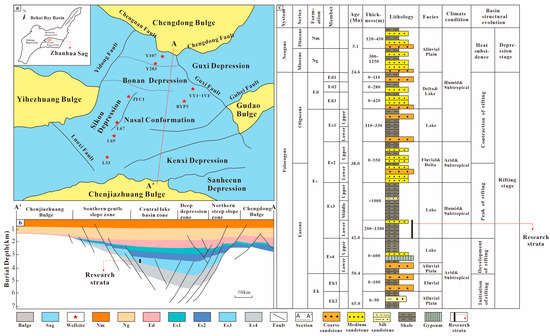
Figure 1.
Simplified tectonic map and composite columnar diagram of the Zhanhua Sag area (modified from [8]). (a) Zhanhua sag regional structural schematic. (b) Zhanhua sag regional stratigraphic framework cross-section. (c) Comprehensive stratigraphic column of Paleogene and Neogene in Zhanhua sag.
The Paleogene is the main extensional rifting period in the Zhanhua Sag, depositing the Kongdian Formation, Shahejie Formation, and Dongying Formation successively from bottom to top. The Shahejie Formation is divided into four members. Before the emergence of Member 3 of the Shahejie Formation, the fault activity in the Zhanhua Sag was relatively weak, and the climate was arid, resulting in the development of shore-shallow deposits. During the deposition of , the form of depression was intense subsidence, with increased crustal stretching and accelerated subsidence. The overall basin environment transitioned from a deep lake to a semi-deep lake. The climate changed from a subtropical arid to a subtropical humid climate, with increased water depth, creating a salty to semi-saline environment [8,18,19]. Driven by climate and tectonics, the central part of the basin in accumulated thick, organic-rich, fine-grained sedimentary rocks with a thickness exceeding 1000 m. This makes it a key target for shale oil exploration in the Shengli Oilfield (Figure 1c).
3. Materials and Methods
in the Zhanhua Sag is divided into five sand units, denoted as Units 9–13. This study focused on the most promising units, Units 12–13, for shale oil exploration in the Zhanhua Sag. We analyzed the core and logging data from 96 drilling wells. We made detailed observations of and conducted detailed analysis on the cores of Units 12–13 in from five critical mud shale system core wells, namely L67, L69, JYC1, YY1-1VF, and BYP5. The continuous core lengths of these wells are 48 m, 68 m, 95 m, 395 m, and 71 m, respectively. Based on high-precision vertical sampling of the cores (with a sampling interval of 25 cm), we analyzed thin sections (695 samples), conducted X-ray diffraction analysis of whole-rock minerals (345 samples), and analyzed total organic carbon (TOC) content (180 samples).
Because previous studies have extensively researched conventional sedimentary facies (such as nearshore subaqueous fans, carbonate shoals, etc.) in the study area [10,20,21], this paper does not delve into a detailed analysis of them. Using the mentioned data, in this study, we analyzed and summarized the material composition and sedimentary characteristics of fine-grained sedimentary rocks, delineated types of lithofacies, and analyzed their genesis mechanisms. Simultaneously, key mudstone core wells in the study area were selected for single-well facies analysis and to establish a composite well section in order to identify profile distribution characteristics, providing boundary constraints for planar lithofacies distribution. To obtain a more intuitive representation of the planar distribution of lithofacies, dominant lithofacies developed in the region were selected for the construction of planar facies figures. Ultimately, a model of fine-grained sedimentation in the rifted lake basin was established.
4. Results
4.1. Lithofacies Types and Genetic Mechanisms
4.1.1. Sediment Compositions
The whole-rock mineral data in the study area show that the mineral composition of the fine-grained sedimentary rocks in in the Zhanhua Sag includes calcite, dolomite, quartz, feldspar, clay minerals, pyrite, siderite, and anhydrite, indicating a complex composition (Table 1). Calcite is the dominant mineral, with an average content ranging from 21.5% to 60.5% in different wells. Quartz and clay minerals have relatively lower content, with an average content ranging from 15.5% to 32.8% for the former and from 13.0% to 28.9% for the latter in each well. The content of illite is the highest among clay minerals, followed by chlorite and kaolinite. The content of other minerals accounts for less than 10%. Additionally, scattered authigenic pyrite is observed. The calcite content gradually increases from the northern steep slope zone to the southern gentle slope zone, while the content of quartz and clay minerals gradually decreases. The average TOC content values of fine-grained sedimentary rocks in the deep depression zone are 3.0% and 2.9%, while in the gentle slope zone in the south, these values are 1.9% and 2.2%. Overall, the deep depression zone in the study area has higher TOC content than the southern gentle slope zone.

Table 1.
Average mineral composition of fine-grained sedimentary rocks in the target intervals of the Zhanhua Sag.
4.1.2. Petrographic Types
Based on whole-rock X-ray diffraction results, in this study, we adopted the “three-end-member” lithofacies classification method, depicting a ternary diagram based on the content of clay minerals, carbonate minerals, and felsic minerals, which dominate the material composition (Figure 2).
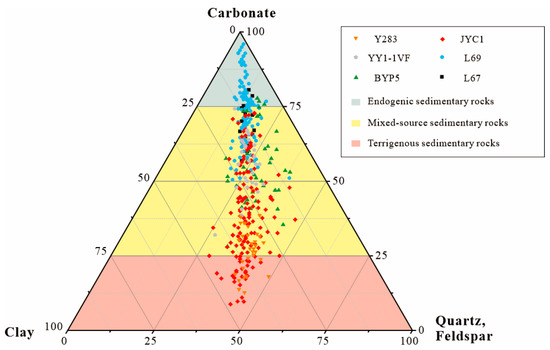
Figure 2.
Ternary diagram of the composition of fine-grained sedimentary rocks in the Zhanhua Sag target interval.
Classification schemes for fine-grained sedimentary rocks often use clay, felsic, and carbonate minerals as the three end members. These schemes divide fine-grained sedimentary rocks into four categories, namely claystone, siltstone, carbonate rock, and mixed fine-grained sedimentary rock, with the boundary set at a content of 50% for each end member [2,12,22,23]. However, the above scheme makes it difficult to accurately reflect the rocks’ sources. For example, the total content of felsic and clay minerals in mixed fine-grained sedimentary rocks can exceed 70%–80%, but these minerals are typically derived from terrestrial sources.
Based on the differences in mineral sources, we propose a unified classification based on the relative content of exogenic clastic components (felsic minerals and clay minerals) and endogenic clastic elements (carbonate minerals) (Figure 2). Using thresholds of 25% and 75% for the content of carbonate minerals, fine-grained sedimentary rocks with a carbonate mineral content below 25% were classified as terrestrial sediments, those with a content between 25% and 75% were classified as mixed-source sediments, and those with a content above 75% were classified as endogenic sediments. Additionally, considering sedimentary structures, the fine-grained sedimentary rocks in the Zhanhua Sag target section were classified into five categories: terrestrial layered-pebbly mudstone, mixed-source pebbly mudstone, mixed-source laminated mudstone, endogenic laminated limestone, and endogenic irregularly-bedded algal limestone. The classification and main characteristics description of each lithofacies are depicted below (Table 2).

Table 2.
Lithofacies type classification and description of the main characteristics.
Terrestrial Layered-Pebbly Mudstone
- 1.
- Description of characteristics
Terrestrial layered-pebbly mudstone consists of a material derived from terrestrial sources, with a combined content of felsic minerals and clay minerals ranging from 75% to 82% (Figure 2, Table 2). The core is generally grey, with the presence of layered-pebbly structures and the absence of laminate (Figure 3a). The thickness of a single sediment layer is approximately 0.5 m. Graded bedding is present, with a smooth contact boundary between the bottom and the dark mudstone (Figure 3b). Additionally, there are clumps of sandstone floating in the mudstone, with precise edges (Figure 3c). Common sediment deformation, original bedding severely disrupted, dark mudstone scattered in clumps and irregular torn fragments within (Figure 3d).
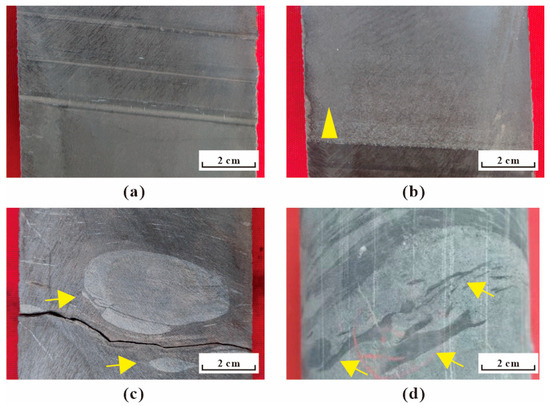
Figure 3.
Sedimentary characteristics of terrestrial layered-pebbly mudstone in the target intervals of the Zhanhua Sag. (a) Well, Y283, 4149.8 m. Terrestrial layered-pebbly mudstone, layered-pebbly bedding. (b) Well, Y283, 4146.9 m. Graded bedding (yellow arrow). (c) Well, Y283, 4126.2 m. Clumps of sandstone floating in mudstone (yellow arrow). (d) Well, Y283, 4456.57 m. Abundant muddy debris scattered in clumps and irregular shapes (yellow arrow).
- 2.
- Explanation of genetic mechanisms
The development of layered pebbly structures and the absence of laminate indicate a relatively turbulent depositional environment [3,24]. Graded bedding, floating debris, and numerous torn, eroded, and intrusive sedimentary structures reveal the depositional action of gravity flows. Sediments are transported by gravity flows, undergoing deformation and mixing. Overall, this lithofacies is formed in an environment with a strong terrestrial clastic supply and relatively turbulent water conditions [25], and it represents sedimentary deposits of terrestrial origin generated by gravity flow.
Mixed-Source Pebbly Mudstone
- 1.
- Description of characteristics
The carbonate mineral content in the mixed-source pebbly mudstone ranges from 35% to 50%, the felsic mineral content ranges from 25% to 44%, and the clay mineral content ranges from 14% to 28% (Figure 2, Table 2). The core is predominantly grey to grey-black, with prominent blocky, rare, laminated structures. Numerous calcite veins are present (Figure 4a). The average sediment thickness is 1.5 m. The original sedimentary system of the mudstone is disrupted, with the presence of banded or clump-like muddy tear fragments and irregular sandy debris scattered within (Figure 4b). Additionally, abundant gravity flow sedimentary features can be observed, such as the deformation of soft sediments and graded bedding (Figure 4c,d). Under microscopic observation, the distribution of various components is chaotic, with little to no laminate (Figure 4e,f). Abundant quartz particles are randomly distributed, with poor sorting and lacking overall orientation. Clay minerals are mixed with cryptocrystalline calcite, making them difficult to distinguish. Pyrite, foraminiferal fragments, and carbonaceous debris are randomly distributed. The average organic matter content is 3%.
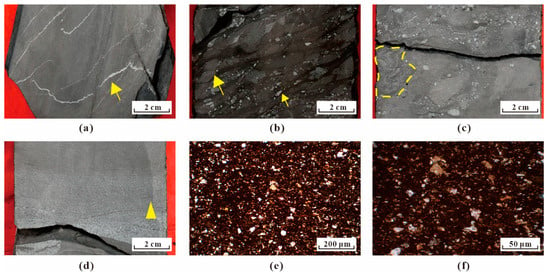
Figure 4.
Sedimentary characteristics of mixed-source pebbly mudstone in the target intervals of the Zhanhua Sag. (a) Well BYP5, 4284.2 m. Mixed-source pebbly mudstone, with calcite veins (yellow arrow). (b) Well BYP5, 4274.8 m. Banded or clumpy muddy tear fragments and irregular sandy debris (yellow arrow). (c) Well BYP5, 4297.0 m. Deformation of soft sediment (yellow dotted line). (d) Well BYP5, 4299.9 m. Graded bedding (yellow arrow). (e) Well, BYP5, 4293.2 m. A mixed distribution of particles beneath the thin section, poor roundness, and no laminae. (f) Local magnification of (e) in a thin section.
- 2.
- Explanation of genetic mechanisms
Pebbly structures typically indicate a rapid accumulation of sediment [24,26]. Sedimentary structures such as graded bedding, the deformation of soft sediment, and abundant muddy rip-up clasts indicate gravity flow deposits generated by floods or landslides [27,28]. It can be inferred that during the deposition of the Shahejie Formation, there was an abundant supply of sediment from the source rocks in the northern uplifted area of the study area. Event-triggered gravity flow deposition occurred in the northern steep slope zone, transporting a great deal of terrestrial material to the deep depression zone through mechanical action. Due to the strong gravitational flow energy and a large sediment load, fine silt and clay clasts were unable to segregate, leading to rapid deposition. At the same time, the consolidation or semi-consolidation of the fine-grained sedimentary rock on the lake bottom was disturbed and fragmented, causing a mixture of terrestrial material and endogenic carbonate components to re-deposit, forming mixed-source pebbly mudstone [29]. The relatively high TOC content is speculated to be due to the fact that this lithofacies is located in the deepest part of the sag, which exhibits the highest water reductiveness in the entire study area. In conclusion, this lithofacies represents a mixed sedimentary product of vital terrestrial input and endogenic mixing influenced by event deposition.
Mixed-Source Laminated Mudstone
- 1.
- Description of characteristics
The carbonate mineral content in the mixed-source laminated mudstone ranges from 25% to 50%, while the felsic mineral and clay mineral content ranges from 25% to 50% and 18% to 40%, respectively (Figure 2, Table 2). The core is overall dark gray, with high-frequency interleaving of light and dark laminae. The laminae are straight, with stable thickness, good lateral continuity, and clear boundaries (Figure 5a). The average sedimentary thickness of this lithology is 0.8 m. Thin layers of silt can be observed, usually with abrupt contacts at the top and a 1–2 cm thickness. The internal grain size is hardly visible (Figure 5b). Under microscopic observation, the laminaes appear microwavy, with individual laminae thicknesses below 50 μm. The light-colored laminaes are mainly composed of cryptocrystalline calcite. They are relatively continuous, while the dark laminaes are composite laminaes composed of organic matter and clay minerals with a somewhat greater thickness than the light-colored laminaes. Unlike endogenic laminated mudstone, the proportion of light-colored laminaes is relatively higher. Angular to the subrounded ones, elongated clastic grains are dispersed in a scattered distribution (Figure 5c). Fishbone fossils can occasionally be found in the laminaes (Figure 5d).
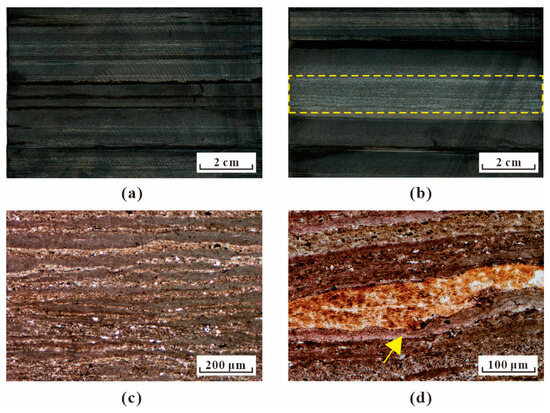
Figure 5.
Sedimentary characteristics of mixed-source laminated mudstone in the target intervals of the Zhanhua Sag. (a) Well JYC1, 3564.31 m. Mixed-source laminated mudstone, with light-colored laminaes vertically overlaid by dark-colored laminaes. (b) Well JYC1, 3591 m. The thin laminaes of silt exhibit a nearly horizontal texture, with consistent lithology both above and below. There is almost no visible grain size variation in the vertical direction (yellow dotted line). (c) Well JYC1, 3580.06 m. Overall, the light-colored laminaes present a microwaved appearance, which is relatively continuous, with thinner dark-colored laminaes. (d) Well JYC1, 3566.57 m. Fishbone fossil (yellow arrow).
- 2.
- Explanation of genetic mechanisms
The thin layers of the silt indicate the presence of terrestrial sediment supply [29]. On the other hand, clear and intact laminations are typically formed by seasonal variations. Carbonate minerals, clay, and organic matter, formed through seasonal mechanical–biochemical processes, respectively, contribute to the formation of various continuous laminated sediments [30,31]. The specific formation mechanism of these laminated structures is as follows: During the spring and summer, intense sunlight and increased surface water temperature, along with abundant nutrients, lead to the proliferation of algae, which consume a large amount of CO2. Subsequently, the oversaturation of calcite is induced, leading to the precipitation of calcite laminae. During the fall and winter, water stratification induces oxygen deficiency in the bottom laminae, leading to the death of algae and other planktonic organisms. The remains are degraded, producing organic matter. This organic matter is often adsorbed by suspended clay minerals and, in relatively quiescent water bodies, periodically deposits in a flocculated state, forming clay–organic laminae [32,33]. Overall, the lithofacies are incorporated into a semi-deep to deep water environment with a relatively abundant sediment input, and they are a product of mechanical-biochemical mixed sedimentation.
Endogenic Laminated Limestone
- 1.
- Description of characteristics
The carbonate mineral content in the endogenic laminated limestone is greater than 75% (Figure 2, Table 2). The total organic carbon (TOC) content is relatively low, generally ranging from 1% to 2%, with an average of 1.2%. The core is grey to dark grey, with straight and rhythmic high-frequency interlayers of light and dark laminaes (Figure 6a). The average sediment thickness is 0.4 m. Under microscopic observation, it can be seen that the light laminaes are mainly composed of cryptocrystalline calcite, which is clean internally and contains a small amount of dolomite, while the dark laminaes are formed of clay minerals (Figure 6b). The thickness of the laminaes is in the micrometer range, with light laminaes ranging from 20 to 50 μm in thickness and dark laminaes being less than 20 μm in thickness, with light-colored laminaes dominating. The horizontally stable nature of the abundant cryptocrystalline calcite laminaes is poor, exhibiting discontinuous wave-like and lens-like forms (Figure 6c). A large quantity of fragmented bioclasts, mainly composed of foraminiferas, is visible in the rock. Benthic green algae and biological particle clusters can also be observed (Figure 6d–f).
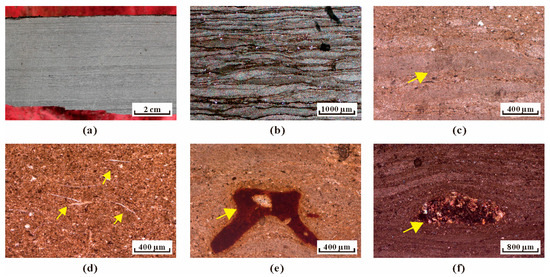
Figure 6.
Sedimentary characteristics of endogenic laminated limestone in the target intervals of the Zhanhua Sag. (a) Well L67, 3087.2 m. Endogenic laminated limestone. (b) Well L69, 3102.9 m. The light-colored cryptocrystalline calcite is thicker than the dark-colored clay-organic matter laminaes, and most of it appears as discontinuous, laminated, and lens-shaped structures. (c) Well L69, 3107.15 m. The interior of cryptocrystalline calcite laminaes is relatively pure (yellow arrow). (d) Well L69, 3125.70 m. Abundant fragments of foraminifera (yellow arrow). (e) Well L69, 3105.40 m. Benthic green algae (yellow arrow). (f) Well L69, 3082.40 m. Organic matter clumps (yellow arrow).
- 2.
- Explanation of genetic mechanisms
The high content of calcite and the observation of relatively pure cryptocrystalline calcite laminae suggest that chemical precipitation is predominant in high-salinity water bodies, leading to the oversaturation and precipitation of calcite [34]. The discontinuous and lens-shaped micritic laminae of cryptocrystalline calcite laminae indicate an intermittent enhancement of water dynamics during deposition [35]. The laminae are disrupted in turbulent aquatic environments, and the lower organic matter content suggests poor preservation conditions for organic matter. Both factors indicate relatively shallow water conditions with limited input of terrigenous materials and strong water dynamics. In conclusion, this lithofacies formed as a product of chemical processes in a shallow water environment.
Endogenic Irregularly Bedded Algal Limestone
- 1.
- Description of characteristics
The average content of carbonate minerals in the endogenic irregularly bedded algal limestone is above 75% (Figure 2, Table 2). The core appears light grey to grey, predominantly in a blocky form (Figure 7a). Individual layers of algal limestone are generally only a few centimeters to over 20 cm thick. Under microscopic observation, a large number of algae particles with random distribution can be seen. The algae particles appear spherical, with a diameter of approximately 50–200μm. The particles are bound together by the cementation of calcite (Figure 7b), and localized bioturbation phenomena can be observed (Figure 7c). In addition, gastropod fossils, stromatolite structures, and bird’s eye structures are also present (Figure 7d–f).
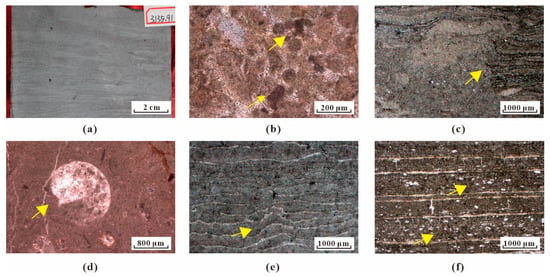
Figure 7.
Sedimentary characteristics of endogenic irregularly bedded algal limestone in the target intervals of the Zhanhua Sag. (a) Well L69, 3135.91 m. Endogenic irregularly bedded algal limestone. (b) Well L69, 3124.70 m. Algal grains are particle-supported and exhibit a non-directional distribution (yellow arrow). (c) Well L69, 3133.40 m. Bioturbation phenomena (yellow arrow). (d) Well L69, 3137.70 m. Gastropod fossils (yellow arrow). (e) Well L69, 3128.95 m. Stromatolite structure (yellow arrow). (f) Well L69, 3133.40 m. The bird’s eye structure, filled with calcite, is arranged in parallel layers (yellow arrow).
- 2.
- Explanation of genetic mechanisms
Blue–green algae, green algae, and other algae that do not possess calcareous shells or skeletons are commonly referred to as “cryptophytes.” They form algal limestone by secreting mucus and capturing and cementing carbonate particles [36,37]. Algal grains and laminated stromatolites typically form in shallow water environments with low terrigenous input [8]. Bird’s eye structures arranged in parallel indicate shallow water during the deposition period. They form when the lake level periodically falls, exposing them to the surface. In summary, the lithofacies are deposited in a lowland source material input, a shallow water environment. However, the water depth is more superficial than that of endogenic laminated mudstone. It is an endogenic sedimentation created by algal precipitation and cementation.
4.2. Spatial and Temporal Distribution Patterns of Fine-Grained Sedimentary Rocks
4.2.1. Characteristics of Profile Distribution
Near the northern source direction, the steep slope zone mainly consists of terrestrial layered-pebbly mudstone, interbedded with multiple segments of terrestrial conglomerates, with thicknesses ranging from 2 to 5 m, and these two types of lithofacies are stacked on top of each other. Eight small depositional cycles have occurred, decreasing the grain size from the bottom to the top, such as near Well Y107. In the deep depression zone, episodic sedimentation of mixed-source pebbly mudstone has mainly occurred, with this layer being vertically interbedded with mixed-source laminated mudstone and terrestrial layered-pebbly mudstone. Multiple thin layers of terrestrial conglomerates are observed, such as near Well YY1-1VF. The central lake basin zone has a slight vertical variation, mainly characterized by mixed-source laminated mudstone, with some terrestrial layered-pebbly mudstone at the bottom, such as near Well JYC1. In the vertical direction, in the southern gentle slope zone, from the bottom to the top, there are instances of endogenic irregularly bedded algal limestone, endogenic laminated limestone, and mixed-source laminated mudstone. The endogenic irregularly bedded algal limestone is only present in a layer of about ten meters at the bottom, near Wells L69 and L67. Overall, there is a sequence of development from the northern steep slope zone to the southern gentle slope zone, including terrigenous gravity flow deposits, mixed-source gravity flow deposits, mixed-source mechanical–biochemical deposits, and endogenic biogenic/chemical deposits (Figure 8).
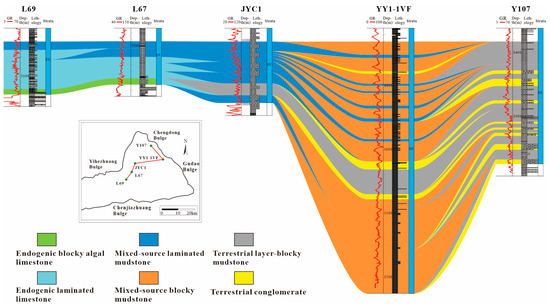
Figure 8.
Lithofacies characteristics of the target interval SN-oriented continuous good section in
4.2.2. Planar Distribution
In a planar view, the lithofacies are generally centered around the central basin, with east–west symmetry and a characteristic belt-like distribution (Figure 9). Terrestrial layered-pebbly mudstone and mixed-source pebbly mudstone are present in the northern steep slope zone and the deep depression zone, respectively. The terrestrial layered-pebbly mudstone is distributed at the front and sides of the nearshore subaqueous fans, with both having relatively small scales. In the southern gentle slope zone, endogenic laminated limestone and endogenic irregularly bedded algal limestone are present. The former has a larger scale, while the latter is distributed in the relatively shallow water area of the Luojia nasal structure region structure with a smaller distribution range. Between the northern steep slope zone and the southern gentle slope zone, mixed-source laminated mudstone is present in the central lake basin zone where episodic deposition did not have an effect, and it exhibits the largest scale of development.
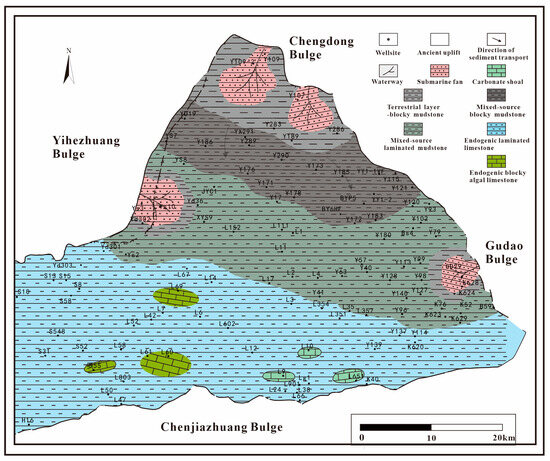
Figure 9.
Planar distribution of lithofacies of fine-grained sedimentary rocks in
5. Discussion
5.1. Analysis of the Controlling Role of Fine-Grained Distribution
The distribution patterns of lithofacies are mainly controlled by the supply intensity of terrigenous clastic components. The difference in the intensity of the terrigenous input from north to south in the study area has resulted in a relation of “as one falls, another rises” between the deposition supply of terrigenous clastic minerals outside the basin and carbonate minerals inside the basin. This has led to terrigenous deposition, mixed-source deposition, and endogenic deposition from the northern steep slope zone to the southern gentle slope zone, presenting a banded distribution on a planar scale (Figure 9). Vertically, the supply of terrigenous clastics is to some extent controlled by the climate. In the northern steep slope zone, the terrigenous input is strong under relatively humid climate conditions, leading to coarser sediment particles. Under relatively arid climate conditions, the terrigenous input is comparatively weak, resulting in finer sediment particles and the development of eight small-scale depositional cycles (Figure 8).
5.2. Depositional Model
During , the Zhanhua Sag was a typical rifted lake basin. In addition to the terrigenous debris transported by mechanical action, materials generated by biological and chemical sedimentary processes are also distributed in the basin, resulting in the deposition of different lithofacies of various genetic types at different locations in the basin. Analyzing the lithofacies sedimentary characteristics and their spatial and vertical distribution patterns, we believe that the characteristics of strong terrigenous input in the northern part and weak input in the southern part of the study area control the differential distribution of fine-grained sedimentary rocks. Based on this foundation, a fine-grained rock deposition model for fault depression basins was established (Figure 10).
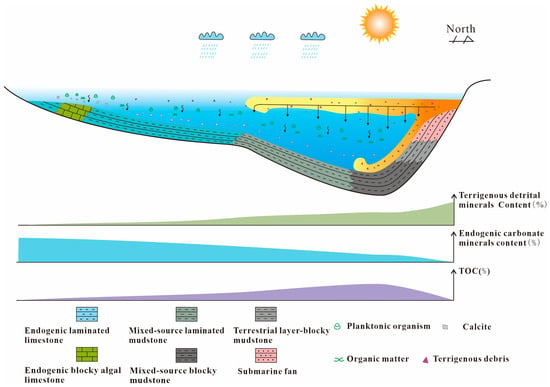
Figure 10.
Fine-grained sedimentary depositional model of
The depositional model for fine-grained rocks in faulted lake basins is summarized as follows. The terrestrial input in the study area mainly comes from the northern uplift [10,37,38]. Medium to coarse clastic sediments (sandstone and conglomerate) are deposited in the northern steep slope zone, forming nearshore subaqueous fans. Under the background of strong terrestrial input, many terrigenous clastic components are transported to the basin through gravity flows and mechanical suspension action. High-intensity gravity flow deposits have settled in the northern steep slope zone and the deep depression zone, forming terrestrial layered-pebbly mudstone and mixed-source pebbly mudstone, respectively. Sediments carried by gravity flows rapidly accumulate, and fine silt and clay cannot be differentiated. Terrestrial layered-pebbly mudstone has been deposited at the front and sides of the fan in the northern steep slope zone. As gravity flows and continues to transport materials, terrigenous clastic minerals mix with endogenic carbonate minerals in the deep depression zone, forming mixed-source pebbly mudstone with high TOC content. The sedimentary environment is relatively quiet in the central lake basin zone, where episodic sedimentation has not occurred. A large amount of terrigenous material suspended and diffused by water flow is periodically deposited with endogenic carbonate minerals [9,25], forming overlapping microwave laminae structures and large-scale mixed-source laminated mudstone.
The southern gentle slope zone has a weak terrestrial input, with endogenic sedimentation being predominant. Carbonate minerals are significantly enriched, and endogenic biogenic and chemical sedimentation occur, resulting in lower TOC content. The salinization of the lake increases water density, creating relatively stable chemical stratification conditions [22,29]. Controlled by the water environment and seasonal climatic variations, carbonate minerals precipitate through chemical processes, forming endogenic laminated limestone. In shallow areas of the water body, algae secrete mucilage to precipitate and bind carbonate particles, forming endogenic irregularly bedded algal limestone [8,36].
In this text, we conduct a genesis mechanism analysis of lithofacies types, elucidating the types of deposition and process mechanisms at different locations within the basin. Based on this, different lithofacies spatial distribution models for various genesis types are constructed. In regions with similar geological backgrounds, some scholars have conducted similar studies using comparable research methods [7,25,29], such as the Dongying Sag in the Bohai Bay Basin. They focused on the upper submember of Member 4 of the Shahejie Formation in the Dongying Sag. Through the analysis of the main sedimentation types occurring in different depositional environments, they summarized the main controlling factors of lithofacies and established a fine-grained rock depositional model for a rifted lake basin. The distinction between the two studies lies in the more significant differences in the distribution of lithofacies distribution in the Zhanhua Sag compared to the Dongying Sag. The reason is that there are differences in the controlling factors in the study area, and the controlled factors in the Zhanhua Sag are more singular, with a more pronounced influence of terrestrial input [14].
The research is crucial for understanding the formation mechanism of reservoir heterogeneity in the fine-grained sedimentary rocks of the Zhanhua Sag. It can provide theoretical support for regional and stratigraphic optimization during shale oil exploration in the study area and lay the groundwork for the next exploration steps. Additionally, it serves as a theoretical basis for predicting favorable facies belts for shale oil and gas in faulted lake basins.
6. Conclusions
(1) Lithofacies types were classified, and genetic mechanism explanations were provided. This research, based on the diverse characteristics of the source supply system in the rifted lake basin, categorizes the fine-grained sedimentary rocks of in the Zhanhua Sag into five lithofacies types: terrestrial layered-pebbly mudstone, mixed-source pebbly mudstone, mixed-source laminated mudstone, endogenic laminated limestone, and endogenic irregularly bedded algal limestone. The lithofacies exhibit a continuous vertical deposition sequence and a banded distribution on a planar scale.
(2) The depositional model for fine-grained rocks in the rifted lake basin was established. Through the analysis of lithofacies sedimentary characteristics and their distribution patterns, it was found that the characteristics of strong northern and weak southern terrestrial input control the differential distribution of fine-grained sedimentary rocks in the study area. In the northern steep slope zone and deep depression zone, gravity flow-induced terrestrial layered-pebbly mudstone and mixed-source pebbly mudstone formed, respectively. In the central lake basin zone, mixed-source laminated mudstone formed, influenced by mechanical–biochemical processes. In the southern gentle slope zone, endogenic irregularly bedded algal limestone and endogenic laminated limestone were present, formed through biological cementation and chemical precipitation, respectively. Through comparing the results with basins of similar geological backgrounds, similarities were found, but in the study area, the differential distribution of lithofacies was more pronounced, and the controlling factors were more singular.
(3) The research results have implications for oil and gas exploration in other faulted lake basins. The lithofacies classification scheme, identified lithofacies distribution patterns, and the depositional model summarized in this study address the unclear understanding of the differential distribution of fine-grained sedimentary rocks in the faulted lake basin. This work solidifies the foundation for favorable area prediction and evaluation. The findings serve as a theoretical basis for predicting favorable zones for shale oil and gas in faulted lake basins, with the lithofacies classification scheme being particularly relevant for shale oil and gas studies in other types of basins.
Author Contributions
Conceptualization, R.X., J.Z. and Q.Z.; Methodology, R.X.; Software, R.X.; Validation, J.Z.; Investigation, J.Z.; Resources, R.X.; Data curation, R.X.; Writing—original draft preparation, R.X.; Writing—review and editing, R.X.; Visualization, R.X.; Supervision, R.X.; Project administration, J.Z. All authors have read and agreed to the published version of the manuscript.
Funding
This research received no external funding.
Data Availability Statement
Data are contained within the article.
Acknowledgments
We thank the Sinopec Shengli Oilfield for its core samples and geological data.
Conflicts of Interest
The authors declare no conflict of interest.
References
- Aplin, A.C.; Macquaker, J.H.S. Mudstone diversity: Origin and implications for source, seal, and reservoir properties in petroleum systems. AAPG Bull. 2011, 95, 2031–2059. [Google Scholar] [CrossRef]
- Jiang, Z.X.; Liang, C.; Wu, J.; Zhang, J.G.; Zhang, W.Z.; Wang, Y.S.; Liu, H.M.; Chen, X. Several issues in sedimentological studies on hydrocarbon-bearing fine-grained sedimentary rocks. Acta Pet. Sin. 2013, 34, 1031–1039. [Google Scholar]
- Zhu, R.K.; Li, M.Y.; Yang, J.R.; Zhang, S.R.; Cai, Y.; Cao, Y.; Kang, Y. Advances and trends of fine-grained sedimentology. Oil Gas Geol. 2022, 43, 251–264. [Google Scholar]
- Zhang, S.; Liu, H.M.; Chen, S.Y.; Wang, Y.S.; Pu, X.G.; Zhang, K.H.; Han, W.Z. Classification Scheme for Lithofacies of Fine-Grained Sedimentary Rocks in Faulted Basins of Eastern China: Insights from the Fine- Grained Sedimentary Rocks in Paleogene, Southern Bohai Bay Basin. Acta Geol. Sin. 2017, 91, 1108–1119. [Google Scholar]
- Du, X.F.; Xu, C.G.; Zhu, H.T.; Xie, X.N.; Zhu, X.M.; Liu, K.Y.; Jiang, Z.X.; Zeng, H.L. Research Advances of Mixed Siliciclastic and Carbonate Sediments in Continental Rift Basins. Earth Sci. 2020, 45, 3509–3526. [Google Scholar]
- Guo, L.Y. Heterogeneity and Controlling Factors of Organic-Rich Shale in Continental Rift Basin: A Case Study of Biyang and Zhanhua Depressions. Ph.D. Thesis, China University of Geosciences, Wuhan, China, 2017. [Google Scholar]
- Liu, H.M.; Wang, Y.; Yang, Y.H.; Zhang, S. Sedimentary Environment and Lithofacies of Fine-Grained Hybrid Sedimentary in Dongying Sag:A Case of Fine-Grained Sedimentary System of the Es4. Earth Sci. 2020, 45, 3543–3555. [Google Scholar]
- Zhang, J.G.; Jiang, Z.X.; Liu, L.A.; Yuan, F.; Feng, L.Y.; Li, C.S. Lithofacies and depositional evolution of fine-grained sedimentary rocks in the lower submember of the Member 3 of Shahejie Formation in Zhanhua sag, Bohai Bay Basin. Acta Pet. Sin. 2021, 42, 293–306. [Google Scholar]
- Wu, J.; Jiang, Z.X.; Pan, Y.W.; Zhang, Q.S.; He, L.Q. Lacustrine fine- grained depositional model: A case study of the upper submember of the fourth Member of Paleogene Shahejie Formation in Dongying sag. Acta Pet. Sin. 2016, 37, 1080–1089. [Google Scholar]
- Liu, H.M.; Yang, H.Y.; Zhang, P.F.; Han, T.X.; Liu, X.J. Control effect of paleolacustrine water conditions on mixed lithofacies assemblages: A case study of the Palaeogene Es3, Dongying Sag, Bohai Bay Basin. Oil Gas Geol. 2022, 43, 297–306. [Google Scholar]
- Zhu, D.S. Sedimentary Law of Shale in Deep Lake Environment in Zhanhua Area and Its Sale Oil Geological Significance. J. Shengli Coll. China Univ. Pet. 2022, 36, 26–29. [Google Scholar]
- Peng, J.; Zeng, Y.; Yang, Y.M.; Yu, L.D.; Xu, T.Y. Discussion on classification and naming scheme of fine-grained sedimentary rocks. Pet. Explor. Dev. 2022, 49, 106–115. [Google Scholar] [CrossRef]
- Dong, D.T.; Qiu, L.W.; Ma, Y.D.; Yang, Y.Q.; Zou, Y.; Dai, L.; Teng, B.G.; Zhang, Z.P. Control of tectonics on sedimentation of sandstone and process of sediment flling in multi-fault lacustrine basins: A case study on the Eocene in eastern Zhanhua Sag, Jjiyang Depression in Bohai Bay Basin. Oil Gas Geol. 2018, 39, 653–663. [Google Scholar]
- Zhu, X.M.; Liu, F.; Tan, M.X.; Han, X.F.; Zhang, S.P.; Geng, M.Y.; Li, W.; Dong, Y.L. Diagenesis and Genesis of Favorable Reservoir of Fan Delta in Eocene Shahejie Fm.,Zhanhua Sag Jiyang Depression, Bohai Bay Basin. Geol. Rev. 2015, 61, 843–851. [Google Scholar]
- Wu, A.B.; Luo, Q.; Cui, Q.; Zhang, C.; Jiang, Z.X. Dominant migration pathway and accumulation model of petroleum along the consequent fault slope in the fault basin: Taking Gubei Slope of Zhanhua Sag in the Bohai Bay Basin as an example. J. Northeast Pet. Univ. 2020, 44, 53–64+8–9. [Google Scholar]
- Min, W. Shahejie Formation synsedimentary faulting activity in Zhanhua Sag, Bohai Bay Basin and its control on sedimentary filling. Chengdu Univ. Technol. Acad. J. 2020, 47, 557–569+589. [Google Scholar]
- Zhang, C. Hydrocarbon Accumulation Model in Typical Steep Slope Zones of Bohai Bay Basin. Ph.D. Thesis, China University of Petroleum, Beijing, China, 2019. [Google Scholar]
- Wang, H.S.; Hu, T.Y. Analysis of Influence Factors of Shale Oil Formation in Zhanhua Depression of Bohai Bay Basin. Nat. Gas Geosci. 2014, 25 (Suppl. S1), 141–149. [Google Scholar]
- Li, Z.M.; Qian, M.H.; Li, M.W.; Jiang, Q.G.; Liu, P.; Rui, X.Q.; Cao, T.T.; Pan, Y.H. Oil content and occurrence in low medium mature organic-rich lacustrine shales:A case from the 1st member of the Eocene-Oligocene Shahejie Formation in Well Luo-63 and Yi-21, Bonan Subsag, Bohai Bay Basin. Oil Gas Geol. 2017, 38, 448–456+466. [Google Scholar]
- Peng, L. Heterogeneity and Controlling Factors of Lithofacies of the Lower 3rd Member of Paleogene Shahejie Formation Lacustrine Shale in Jiyang Depression. Ph.D. Thesis, China University of Geosciences (Beijing), Beijing, China, 2017. [Google Scholar]
- Zhao, L.J. The Forming Environment of Fine grained Sedimentary Rocks of the Lower Third Member of Paleogene Shahejie Formation, Bonan Sag. Master’s Thesis, China University of Geosciences (Beijing), Beijing, China, 2017. [Google Scholar]
- Jiang, Z.X.; Zhang, J.G.; Kong, X.X.; Xie, H.Y.; Cheng, H.; Wang, L. Research progress and development direction of continental shale oil and gas deposition and reservoirs in China. Acta Pet. Sin. 2023, 44, 45–71. [Google Scholar]
- Hao, Y.Q.; Xie, Z.H.; Zhou, Z.L.; Tian, F.; Teng, J.B.; Li, B. Discussion on multi-factors identification of mudstone and shale. Pet. Geol. Recovery Effic. 2012, 19, 16–19+24+112. [Google Scholar]
- Wang, X.R.; Sun, Y.; Liu, R.H.; Li, Z. Research Progress into Fine-grained Sedimentary Rock Characteristics and Formation in a Continental Lake Basin. Acta Sedimentol. Sin. 2023, 41, 349–377. [Google Scholar]
- Wang, Y.; Liu, H.M.; Song, G.Q.; Xiong, W.; Zhu, D.S.; Zhu, D.Y.; Yin, Y.; Ding, J.H.; Yang, W.Q.; Zhang, L.; et al. Lacustrine shale fine- grained sedimentary system in Jiyang depression. Acta Pet. Sin. 2019, 40, 395–410. [Google Scholar]
- Deng, H.W.; Qian, K. The genetic types and association evolution of deep lacustrine facies mudstones. Acta Sedimentol. Sin. 1990, 8, 1–21. [Google Scholar]
- Yang, R.C.; Yin, W.; Fan, A.P.; Han, Z.Z.; Loon, A.J.V. Fine- grained, lacustrine gravity-flow deposits and their hydrocarbon significance in the Triassic Yanchang Formation in southern Ordos Basin. J. Palaeogeogr. (Chin. Ed.) 2017, 19, 791–806. [Google Scholar]
- Jiang, C. Characteristics and model of gravity flow sand body deposition in the slope zone of rifted lacustrine basin:A case study from the Sha3 member in the south slope zone of Bonan Sag, Zhanhua Depression. Pet. Geol. Recovery Effic. 2018, 25, 6–13. [Google Scholar]
- Chen, S.Y.; Zhang, S.; Liu, H.M.; Yan, J.H. Discussion on mixing of fine-grained sediments in lacustrine deep water. J. Palaeogeogr. (Chin. Ed.) 2017, 19, 271–284. [Google Scholar]
- Anderson, R.Y.; Dean, W.E. Lacustrine varve formation through time. Palaeogeogr. Palaeoclimatol. Palaeoecol. 1988, 62, 215–235. [Google Scholar] [CrossRef]
- Lindqvist, J.K.; Lee, D.E. High-frequency paleoclimate signals from Foulden Maar, Waipiata Volcanic Field, southern New Zealand: An Early Miocene varved lacustrine diatomite deposit. Sediment. Geol. 2009, 222, 98–110. [Google Scholar] [CrossRef]
- Freytet, P.; Verrecchia, E.P. Lacustrine and palustrine carbonate petrography: An overview. J. Paleolimnol. 2002, 27, 221–237. [Google Scholar] [CrossRef]
- Wu, J.; Jiang, Z.X.; Liang, C. Lithofacies characteristics of fine-grained sedimentary rocks in the upper submember of Member 4 of Shahejie Formation, Dongying sag and their relationship with sedimentary environment. Acta Pet. Sin. 2017, 38, 1110–1122. [Google Scholar]
- Jiang, Z.X.; Kong, X.X.; Yang, Y.P.; Zhang, J.G.; Zhang, Y.F.; Wang, L.; Yuan, X.D. Multi-source genesis of continental carbonate rich fine-grained sedimentary rocks and hydrocarbon sweet spots. Pet. Explor. Dev. 2021, 48, 26–37. [Google Scholar] [CrossRef]
- Ma, Y.Q.; Liu, H.M.; Zhang, S.P.; Lu, Y.C.; Liu, X.F. Types of Fine-Grained Mixed Sedimentary Rocks of Shahejie Formation and Evolution of Lake Basin in Jiyang Depression, Eastern China. Earth Sci. 2020, 45, 3633–3644. [Google Scholar]
- Chen, Y.; Xia, X.M.; Zhao, J.; Cui, J.; Qiao, B.H.; Zhao, D.S.; Gao, H.C.; Wang, Y.; Tan, L. Sedimentary Characteristics and Formation Mechanisms of Neogene Algal Limestone in Western Qaidam Basin. Acta Sedimentol. Sin. 2022, 40, 1323–1334. [Google Scholar]
- Chen, Q. Study on Sedimentary Characteristics of the Lower Part of the Third Member of Shahejie Formation in Luojia Area, Zhanhua Sag. Master’s Thesis, China University of Geosciences (Beijing), Beijing, China, 2012. [Google Scholar]
- Chao, J. Study on Shale Reservoir Characteristics of the Lower 3th Member of Shahejie Formation, Luojia Area, Zhanhua Sag. Ph.D. Thesis, China University of Geosciences (Beijing), Beijing, China, 2014. [Google Scholar]
Disclaimer/Publisher’s Note: The statements, opinions and data contained in all publications are solely those of the individual author(s) and contributor(s) and not of MDPI and/or the editor(s). MDPI and/or the editor(s) disclaim responsibility for any injury to people or property resulting from any ideas, methods, instructions or products referred to in the content. |
© 2024 by the authors. Licensee MDPI, Basel, Switzerland. This article is an open access article distributed under the terms and conditions of the Creative Commons Attribution (CC BY) license (https://creativecommons.org/licenses/by/4.0/).